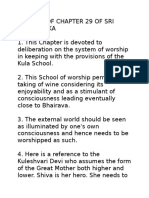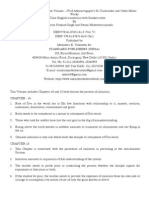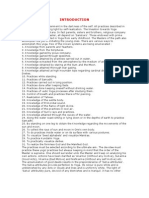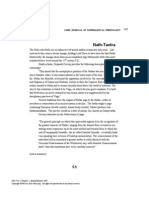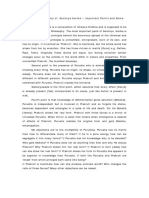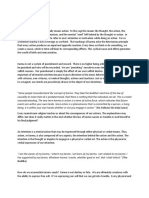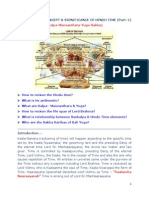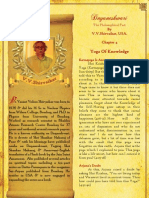Summary of Vol. VIII of Abhinavagupta's Sri Tantraloka and Other Works
Summary of Vol. VIII of Abhinavagupta's Sri Tantraloka and Other Works
Uploaded by
MukeshCopyright:
Available Formats
Summary of Vol. VIII of Abhinavagupta's Sri Tantraloka and Other Works
Summary of Vol. VIII of Abhinavagupta's Sri Tantraloka and Other Works
Uploaded by
MukeshCopyright
Available Formats
Share this document
Did you find this document useful?
Is this content inappropriate?
Copyright:
Available Formats
Summary of Vol. VIII of Abhinavagupta's Sri Tantraloka and Other Works
Summary of Vol. VIII of Abhinavagupta's Sri Tantraloka and Other Works
Uploaded by
MukeshCopyright:
Available Formats
Summary of the Contents of the Volume VIII of Abhinavaguptas Sri Tantraloka and Other Minor Works First Time
e English translation with Sanskrit texts By Professor Satya Prakash Singh and Swami Maheshvarananda ISBN 978-81-87471-84-4 (Vol. VIII) ISBN 978-81-87471-86-8 (Set) Published by Mohindra K. Vashistha for STANDARD PUBLISHERS (INDIA) 205, Kiran Mansion, 2nd Floor, 4834/24 Main Ansari Road, Daryaganj, New Delhi-110 002 (India) Tel. No. 91-011-23240594, 23240593 91-9871009093 (M) Tele FAX - 011-23272338 E-mail: standardpublishersindia@gmail.com mkvsr9@gmail.com Website: http://www.indianbooksworldwide.com This volume consist of 8 chapters namely, 30-37 besides Appendices of 13 minor works Acrya Abhinavagupta. Chapter 30 Mantras Applicable to Trika System of Worship 1. This Chapter deals with seed-mantras of three approaches to the Reality known as dk vidy, mokd vidy and pramevar vidy. 2. There is a reference to three verses in the ry Metre which remind the person lying on the deathbed of the essential nature of his being as existence, consciousness and bliss and therefore he need not be aggrieved of his present state of pain and suffering as it is only an exterior and temporary phase of his eternal and delightful being and remain as such while answering to the queries of anyone. 3. Thus as many as fifteen statements are uttered to stimulate the awareness of the dying person to the essential nature of his being with the aim of getting him detached from the present physical body and be attracted towards his assumption of the spiritual body in oneness with iva. 4. This Brahma-vidy consisting of fifteen statements is known as bound by kals, factors of division. Now is being spelled out what lies above this factor of division. 5. 6. Then there is a form of initiation known as paro-upaniad. Following it, there is a reference to the vidy of initiation, dk vidy.
Chapter 31 Deliberation on Maalas 1. This chapter is devoted to the process of formation of the circle, maala.
2. It speaks of sacrifice known as Dmara which is considered as having embedded in it the three forces, namely, the higher, higher-lower and lower. Chapter 32 Mudr 1. This Chapter deals with the system of postures, mudr.
2. Posture, mudr, is the reflection of the status of the inner being. The inner being or tm is the reflector while bodily posture is the reflection of its status. 3. The word mudr is formed out of mud meaning delight and the root r in the sense of giving. Thus mudr is that which accords delight to the poser concerned. 4. Khecar is the main amongst the mudrs which literally means that which enables the aspirant or its practitioner to move in the void which may take two forms lifting from the gravitational pull of the earth physically or at least mentally and spiritually. 5. Its varieties are known as trilin, karaki, krodhan, bhairav, lelihnik, mahpret, yogamudr, jvlin, kobhi and dhruv. 6. It is posed by sitting in the lotus-pose with the back-bone kept straight, the collarbones lowered, the eye-sight kept concentrated on the navel and concentration of consciousness directed to the three vacuums of the body in the forms of three principal nerves, namely, id, pigal and suumn. 7. Then there get manifested a sound, light and breath culminating in the access to iva. The left foot should be placed on the right thigh and the mouth should be stretched by means of the little fingers and the noseby means of the intermediate ones. He needs to make his tongue move speedily producing the sound h h. He should meditatively rise to the top of the head by invoking the three forces of willing, knowing and doing. 8. Sound is pregnant with the force of consciousness and hence with that of the kualin. Having stopped the breath on this point, the aspirant should pierce through the rest of the circles, cakras. 9. Then there is a reference to the akin, another form of the khecar mudr. It is related to the heart. It is also known as paca-kualin. 10. Khecar is the way out to the knowledge of the supernal seed of creation.
Note: Cf. gveda VII.6.30 dit pratnansya retasa jyotis payanti vsaram paro yadidhyate diva. Chapter 34 - Unification of Divine Forces 1. This Chapter is concerned with the experience of the aspirants oneness with the whole of the world. 2. This the atomic approach to iva-hood. Proceeding along this atomic path, the aspirant has to experience his oneness with the akti and then with iva. 3. This path has been suggested by iva Himself.
Chapter 34 Individualistic Approach to iva-hood 1. This Chapter indicates to the way of entry into iva-hood which is the essential nature of the individual. 2. That way is popularly known as the atomic which is in keeping with the individuality of the individual which although is universal and iva Himself and yet is supposed to have got divided into diverse individuals, each exclusive of the other owing to having been operated upon by the force of division, kal and my.
3.
Gradually he comes to himself getting rid of his exclusivity.
4. This happens due to realisation of the great light of iva within oneself. As a result of this realisation, the individual enters into his real nature which obtains in the whole of the world. Getting rid of his exclusivity, he comes to embrace the entire universe well within himself. This secret has been communicated to our School by the Supreme Creator of the universe. Chapter 35 Concordance of All Scriptural Provisions 1. This Chapter deals with the problem of concordance of all scriptural provisions on a certain point. What is being detailed out in this regard is the common conclusion of all approaches to the Reality. This is why it is known as gama. 2. A newly born child has various choices before him to see, touch and accept but he chooses out of those options only what he likes. 3. Which in itself is determined by his innate inclinations which are formed on the basis of the impressions settled in his inner being during experiences of the past. His inclination to eat clay is obviously beyond the range of his choice. It is something unnatural. Even then he becomes inclined to it. This must be due to some inherent cause behind it, which may be the birth of all from the earth. 4. 5. aivism is the system of approach to the Reality closest to the spontaneity of the human nature. Verity of this system has been impressed on me by honourable ambhuntha.
Chapter 36 Tradition of aivism 1. This Chapter is devoted to the tracing of the tradition of aivism.
2. Bhairava, Bhairav, Svacchanda, Lakula, Aurt Gahananea, Brahm, akra and Bhaspati have contributed to the making of this tradition adding one crore of verses each and thus the entire tradition developed ultimately into a text of nine crores of verses. 3. At the stage of Bhaspati it remained comprising one crore verses. Out of this number onefourth of it transmitted to Vman, half to Bhrga, half to Vali, half to Siha, one-fourth to Garua, one-fourth to Vsuki. 4. Half of the remaining verses were brought to the earth from heaven by Rvaa and were transmitted to Bibhana and then to Rma. 5. From Rma the wisdom was transmitted to Lakmaa and from him to Siddhas and Dnavas. The number got divided into two carried onward by rkaha and Tryambaka. 6. Tantrloka is a summary of the wisdom of all these streams of brought together.
Chapter 37 - Conclusion and Dedication 1. This Chapter is the last one of the entire enterprise which is addressed to his supreme Lord iva with the prayer that it is by virtue of His stimulation that the work has reached this end and that therefore it is He Himself who is prayed for giving solace to all those who may go through it. 2. Vis-a-vis the malice of the worldly life, the wisdom propounded here in this work is comparable to the cure of the snake bite.
3. 4. 5.
The device of oneness with iva is like cure of the snake-bite. It is, therefore, imperative for all to take resort to iva. Posture is a concretised representation of mantra so is also the status of the symbol of maala.
6. As soon as the aspirant receives this wisdom from the teacher, he gets redeemed then and there itself with his body to remain there like a mechanical device. 7. This Trika stra, therefore, needs to be accepted as soon as one becomes intimated with it.
8. Kashmir is a part of the earth dwelt in by iva Himself as also by contemplative sages strewn here and there almost everywhere. 9. Besides the fruits like apple and bilva in abundance, wine of various varieties is also available here. 10. 11. 12. 13. The entire region abounds in flowers. The inhabitants of it are poetic, scholarly, heroic and articulate. Women are also beautiful. It also abounds in yoginis, female practitioners of yoga. Here is also the town named Pravara which was established by King Pravarasena.
14. The river Vitast which has descended here as a part of the moon and decorates land. The King had provided our wise ancestor here a palatial residence at the bank of this river along with rich property attached to the palace. 15. It was in the lineage of that ancestor of ours known as Atrigupta that Varhagupta was born in course of time. 16. His son was named Chukhulaka, I, Abhinavagupta am his son. My departed from this world during my early childhood and due to her demise at that state, I became liberated even at that stage. 17. I was initiated in the learning of grammar, logic, literature and poetics by my father as also in the devotion to iva. 18. Besides this, I was made to join the tradition of teachers, Erakanthnanda, Vmanthnanda, Bhtirja, Somnanda. His son was Utpalantha and grandson Lakmanaguptantha and ambhuntha. 19. Towards the close of my life while I have been thinking of joining the family of my brother Manoratha. 20. While I was thinking of this, a few honourable persons happened to come to me including the son of the minister, Kema, Utpala, Abhinava, Cakraka, Padmagupta, Rmagupta and a lady named Vatsalika whose husband had died in youth and was devoted to iva along with her brother who had declined the offer of ministership out of his devotion to iva. 21. She offered her palace and regal amenities for my living.
22.
It is in those favourable conditions of life and working that I have worked out this Tantrloka.
Appendices English translation of 13 other works of Abhinavagupta: 1. 2. 3. 4. 5. 6. 7. 8. 9. 10. 11. 12. 13. Paramrthasra Essence of the Supreme State of Being. Dehastha-Devat-Cakra-Stotram Hymn to the Human Body as a Temple of Divinities. Pacaloki Stotra Five verses on the Glory of iva. Paramdvayadvdaik Bimbapratibimbavda Talk About the View of Reflection Bodhapacadaik Fifteen Verses on Consciousness. Bhairava Stotram Hymn to the Glory of Bhairava Mahopadea-Vimatik Rahasya-Pacadaik Krama Stotram On Krama System Anuttartik On Anuttara Paramrthacarc Deliberation on the Supreme Objective of Life Anubhavanivedanam Tribute of the Inner Experience.
You might also like
- Hatha Yoga Pradipika Swami MuktibodhanandaDocument654 pagesHatha Yoga Pradipika Swami Muktibodhanandamonbitedanstoncul94% (106)
- Unveiling Potential: A Guided Journey to Discover Your Hidden TalentsFrom EverandUnveiling Potential: A Guided Journey to Discover Your Hidden TalentsNo ratings yet
- Pran Band Ha MantraDocument1 pagePran Band Ha MantraSergio PereiraNo ratings yet
- Chapter 29 of Sri TantralokaDocument8 pagesChapter 29 of Sri Tantralokapantone33No ratings yet
- The Aquarian Sadhana - 3HO FoundationDocument8 pagesThe Aquarian Sadhana - 3HO FoundationNicole HawkinsNo ratings yet
- Dokumen - Tips - Purana Purusha Yogiraj PDF Purusha Yogiraj Shyama Charan Lahiri PDF ShyamaDocument2 pagesDokumen - Tips - Purana Purusha Yogiraj PDF Purusha Yogiraj Shyama Charan Lahiri PDF Shyamaa a100% (1)
- Psychology of Yoga1Document3 pagesPsychology of Yoga1Mukesh0% (1)
- Khenting Tai Situ Pa - Way To GoDocument116 pagesKhenting Tai Situ Pa - Way To Gophoenix1220100% (7)
- Summary of Vol. IV of Abhinavagupta's Sri Tantraloka and Other WorksDocument3 pagesSummary of Vol. IV of Abhinavagupta's Sri Tantraloka and Other WorksMukeshNo ratings yet
- Summary of Vol. VI of Abhinavagupta's Sri Tantraloka and Other WorksDocument5 pagesSummary of Vol. VI of Abhinavagupta's Sri Tantraloka and Other WorksMukeshNo ratings yet
- Summary of The Contents of Abhinavagupta's Sri Tantraloka Vol. IXDocument9 pagesSummary of The Contents of Abhinavagupta's Sri Tantraloka Vol. IXMukeshNo ratings yet
- 12 Kalis and Shaktopaya by ParameshvaranandaDocument2 pages12 Kalis and Shaktopaya by Parameshvaranandajuan pablo mejiaNo ratings yet
- Summary of Vol. V Abhinavagupta's Sri Tantraloka and Other Minor WorksDocument3 pagesSummary of Vol. V Abhinavagupta's Sri Tantraloka and Other Minor WorksMukeshNo ratings yet
- Summary of Vol. II of Sri Abhinavagupta's Sri Tantraloka and Other Minor WorksDocument3 pagesSummary of Vol. II of Sri Abhinavagupta's Sri Tantraloka and Other Minor WorksMukesh100% (1)
- Rosarios TrikaDocument131 pagesRosarios TrikajlehtoNo ratings yet
- The Three Malas (Impurities/limitations) According To Kashmir ShaivismDocument1 pageThe Three Malas (Impurities/limitations) According To Kashmir ShaivismSurinder PalNo ratings yet
- Gorakshapaddhati PDFDocument15 pagesGorakshapaddhati PDFVivek TyagiNo ratings yet
- Play of Five Energies of ShivaDocument5 pagesPlay of Five Energies of ShivamanoharlalkalraNo ratings yet
- Translation of ĪPK 4.12Document3 pagesTranslation of ĪPK 4.12Chip WilliamsNo ratings yet
- Step 1: Getting Nowhere Fast: Kundalini (Kundul N) ) From The Pressure of The HeelDocument15 pagesStep 1: Getting Nowhere Fast: Kundalini (Kundul N) ) From The Pressure of The HeelWarrier Nith100% (1)
- DvādaśāntaDocument2 pagesDvādaśāntaGiano Bellona100% (1)
- Studies On Utpaladeva's Ishvara-Pratyabhijna-Vivritti Part III-TorellaDocument11 pagesStudies On Utpaladeva's Ishvara-Pratyabhijna-Vivritti Part III-TorellaraffaeletorellaNo ratings yet
- Sri Lakshman Joo-My Notes - Essence of The Supreme RealityDocument14 pagesSri Lakshman Joo-My Notes - Essence of The Supreme RealityiinselfNo ratings yet
- Śaivism and The Tantric TraditionsDocument632 pagesŚaivism and The Tantric TraditionsswarupiniNo ratings yet
- Meditation and Mantra by Maharaj - The Yoga Sutras of MaharajDocument90 pagesMeditation and Mantra by Maharaj - The Yoga Sutras of MaharajantiX LinuxNo ratings yet
- Beej Yoga KundaliniDocument17 pagesBeej Yoga Kundalinivaraprasady100% (2)
- Kaularnava TantraDocument4 pagesKaularnava TantraTatiana ScreciuNo ratings yet
- Tantra YogaDocument7 pagesTantra Yogahiren1206No ratings yet
- Manthanabhairava of - Dysch by D.WhiteDocument4 pagesManthanabhairava of - Dysch by D.WhiteAnna KavalNo ratings yet
- 0002 PDFDocument237 pages0002 PDFRavi RadhoeNo ratings yet
- Transformations in The Art of Love - Kamakala PracticesDocument28 pagesTransformations in The Art of Love - Kamakala PracticesIboloid BotNo ratings yet
- MandalaDocument2 pagesMandalarwerwerNo ratings yet
- Japa YogaDocument3 pagesJapa Yogaanil.jdhNo ratings yet
- Buddhist Deities and Mantras in The Hindu Tantras (Tantrasarasamgraha and Isanasiva Gurudeva Paddhati) PDFDocument6 pagesBuddhist Deities and Mantras in The Hindu Tantras (Tantrasarasamgraha and Isanasiva Gurudeva Paddhati) PDFanjanaNo ratings yet
- Hatha YogaDocument12 pagesHatha YogaflyingfakirNo ratings yet
- MahakaliDocument1 pageMahakaligaerthNo ratings yet
- Relate To Your Own Essence - KundaliniDocument2 pagesRelate To Your Own Essence - KundaliniErica YangNo ratings yet
- Tuning in Before Your Kundalini Yoga Practice: Sources: The Aquarian Teacher, Page 78, Pages 71-72Document3 pagesTuning in Before Your Kundalini Yoga Practice: Sources: The Aquarian Teacher, Page 78, Pages 71-72Giacomo Maria MagiNo ratings yet
- Nath TantraDocument1 pageNath TantradragijanaNo ratings yet
- Hath A Yoga PhilosophyDocument18 pagesHath A Yoga PhilosophyJayendra Lakhmapurkar100% (1)
- Eyes: Focus Your Eyes On The Tip of The Nose. Mudra: Bring Both Palms in Front of The Heart CenterDocument3 pagesEyes: Focus Your Eyes On The Tip of The Nose. Mudra: Bring Both Palms in Front of The Heart CenterCat BirdsongsNo ratings yet
- Kashmir ShaivismDocument2 pagesKashmir ShaivismsimranNo ratings yet
- अनुस्वारDocument3 pagesअनुस्वारRakesh YadavNo ratings yet
- Saiva Texts LibreDocument48 pagesSaiva Texts LibreAdrienn RéteiNo ratings yet
- Sankhya Karika PDFDocument6 pagesSankhya Karika PDFAlok SharmaNo ratings yet
- Yoga Philosophy of Patanjali-Hariharananda AranyaDocument11 pagesYoga Philosophy of Patanjali-Hariharananda Aranyasukubh100% (1)
- Ananda Marga Ideology and Way of Life in A Nutshell Part 1Document50 pagesAnanda Marga Ideology and Way of Life in A Nutshell Part 1Son PhanNo ratings yet
- The Schools of Kashmir ShaivismDocument10 pagesThe Schools of Kashmir ShaivismGiano BellonaNo ratings yet
- Bija (Seed) Mantras: The Single Syllable SoundsDocument3 pagesBija (Seed) Mantras: The Single Syllable SoundstractorbeamingNo ratings yet
- Yoga Kundalini UpanishadDocument34 pagesYoga Kundalini Upanishadchinmaya hota100% (1)
- Teachings On TantraDocument9 pagesTeachings On TantramindoflightNo ratings yet
- Yoni Tantra (Aghori Version)Document17 pagesYoni Tantra (Aghori Version)antiX LinuxNo ratings yet
- Amritanubhava Traducere ConvDocument30 pagesAmritanubhava Traducere ConvGelu MargineanNo ratings yet
- Kaula MargaDocument1 pageKaula MargaAtman AnandaNo ratings yet
- Hymn To Goddess Kālī - The Kālikā StotraDocument7 pagesHymn To Goddess Kālī - The Kālikā Stotrajuan pablo mejiaNo ratings yet
- Jabal UpanishadDocument2 pagesJabal UpanishadDavid FarkasNo ratings yet
- Karma and Karma YogaDocument4 pagesKarma and Karma YogaNandan AcharyaNo ratings yet
- Yogayajnyavalkya ItxDocument20 pagesYogayajnyavalkya ItxLatinMidgetNo ratings yet
- Lahiri Mahasaya's Divine Quotes On Advaita (Non-Duality)Document2 pagesLahiri Mahasaya's Divine Quotes On Advaita (Non-Duality)tradicionalistaNo ratings yet
- Āgamas and Gives His Benefits To All Sādhakas. He Is Śiva, Sadāśiva, Bhairava, Tumburu, SomaDocument8 pagesĀgamas and Gives His Benefits To All Sādhakas. He Is Śiva, Sadāśiva, Bhairava, Tumburu, SomaGiano Bellona100% (1)
- Bhairava Stotra Shiva Stuti of Sri AbhinavaguptaDocument5 pagesBhairava Stotra Shiva Stuti of Sri AbhinavaguptaBanibrata BhattacharyaNo ratings yet
- Adinatha FaqDocument15 pagesAdinatha FaqXynofobNo ratings yet
- Opening The Door of DharmaDocument13 pagesOpening The Door of DharmaIoana KamiNo ratings yet
- Baglamukhi KavachDocument4 pagesBaglamukhi KavachMukeshNo ratings yet
- Summary of DR FaustusDocument2 pagesSummary of DR FaustusMukesh100% (1)
- Summary of Vol. VII of Abhinavagupta's Sri Tantraloka and Other WorksDocument4 pagesSummary of Vol. VII of Abhinavagupta's Sri Tantraloka and Other WorksMukeshNo ratings yet
- Foundation of YogaDocument13 pagesFoundation of YogaMukeshNo ratings yet
- Summary of The Contents of Vol. III of Abhinavagupta's TantralokaDocument2 pagesSummary of The Contents of Vol. III of Abhinavagupta's TantralokaMukeshNo ratings yet
- Summary of Vol. II of Sri Abhinavagupta's Sri Tantraloka and Other Minor WorksDocument3 pagesSummary of Vol. II of Sri Abhinavagupta's Sri Tantraloka and Other Minor WorksMukesh100% (1)
- Summary of 1st Three Chapters of Sri TantralokaDocument3 pagesSummary of 1st Three Chapters of Sri TantralokaMukesh100% (1)
- Yogic Experience of States of ConsciousnessDocument24 pagesYogic Experience of States of ConsciousnessMukeshNo ratings yet
- Yogic Experience of States of ConsciousnessDocument24 pagesYogic Experience of States of ConsciousnessMukeshNo ratings yet
- Hindi Di ChadarDocument1 pageHindi Di Chadarगणेश पराजुलीNo ratings yet
- Kanakadhara StotramDocument23 pagesKanakadhara Stotramsmiles789No ratings yet
- What Kind of Buddha Is AmitabhaDocument37 pagesWhat Kind of Buddha Is AmitabhaJuan Carlos HincapieNo ratings yet
- Vedanta DarshanaDocument3 pagesVedanta DarshanaABHISHEK 619No ratings yet
- Bhagavad GitDocument23 pagesBhagavad Gitananta84No ratings yet
- V 65Document3 pagesV 65Prathap VimarshaNo ratings yet
- Untouchability by PeriyatDocument139 pagesUntouchability by PeriyatNagarajan VadivelNo ratings yet
- Theme 4 Thinkers, Beliefs and BuildingsDocument9 pagesTheme 4 Thinkers, Beliefs and Buildingsanujdubey01No ratings yet
- Silsilah Wayang Purwa Mawa Carita Jilid 1 2Document111 pagesSilsilah Wayang Purwa Mawa Carita Jilid 1 2Indra Danar WijayaNo ratings yet
- Buddhist CouncilsDocument89 pagesBuddhist CouncilsAbhijyot sahayNo ratings yet
- Indian PhilosophyDocument6 pagesIndian Philosophyaaditya109100% (8)
- Descriptive Text KAMPUS STAHN MPU KUTURAN SINGARAJADocument2 pagesDescriptive Text KAMPUS STAHN MPU KUTURAN SINGARAJADwi Widya kartonoNo ratings yet
- MahatmaDocument47 pagesMahatmarupnathji100% (1)
- Kaala Ganana - Concept & Significance of Hindu Time...Document10 pagesKaala Ganana - Concept & Significance of Hindu Time...bhargavasarma (nirikhi krishna bhagavan)No ratings yet
- About Abhinavagupta: Five Short BiographiesDocument10 pagesAbout Abhinavagupta: Five Short BiographiesRajinder MahindrooNo ratings yet
- Vastu ShastraDocument9 pagesVastu Shastrasantjitr67950% (2)
- Renard (2002, 3) : The Nature of ReligionDocument2 pagesRenard (2002, 3) : The Nature of ReligionEshiebel AgsaldaNo ratings yet
- Gunaseelam TempleDocument8 pagesGunaseelam TempleT Sampath KumaranNo ratings yet
- The Three Worlds-LatestDocument158 pagesThe Three Worlds-Latestgeorge williamson100% (1)
- Emp BT FinalDocument87 pagesEmp BT Finalkumarkrishna709100% (1)
- 47-Dnyaneshwari - Chapter 4Document6 pages47-Dnyaneshwari - Chapter 4SaptarishisAstrologyNo ratings yet
- KuberDocument6 pagesKuberAcharla SatyanarayanaNo ratings yet
- 6 Leadership Lessons From BuddhaDocument16 pages6 Leadership Lessons From BuddhaChetra Tep100% (1)
- Discourse On Wheel of Dhamma - Mahasi Sayadaw-1962Document244 pagesDiscourse On Wheel of Dhamma - Mahasi Sayadaw-1962BuddhaDhammaSangahNo ratings yet
- Panth Is in DangerDocument13 pagesPanth Is in Dangerbanda singhNo ratings yet
- #SPL02080210-10-19-Paper 19 - Comparative Analysis of Planning Principles of Vastu Sastra - Final PDFDocument8 pages#SPL02080210-10-19-Paper 19 - Comparative Analysis of Planning Principles of Vastu Sastra - Final PDFGayathriNo ratings yet
- AjantaDocument5 pagesAjantaShrikant PhatakNo ratings yet
- BK 001982 PDFDocument106 pagesBK 001982 PDFJot Manku100% (2)



